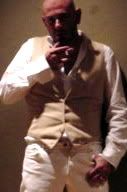

The French architect Claude-Nicolas Ledoux is associated with the late eighteenth centuries return to nature, exeplified in philosophy with Jean-Jacques Rousseau, but in which case with architecture means a return to ancient classical forms of the Greco-Roman. Ledoux's buildings are overtly restrained and severely classical, sometimes categorized as Architecture of the Revolution, exemplifying in masonry the ideals of the new order, stripped of nearly all ornamentation and even at times considered avant-garde by contemporaries.

Nevertheless, some stunning and ethereal buildings are the result, including Madame du Barry's Pavillion du Louviciennes. The design was awarded Ledoux, over the King's architect Ange-Jacques Gabriel's objections, by du Barry; the plans were completed in 1770 and the building itself completed in 1771 and inaugurated on September 2 of that year. Gabriel oversaw completion of the interiors and oranament for the pavilion. Built only as a tableau of reception rooms with views of the Seine valley it proved so popular with the King and his mistress that du Barry intended to replete the building with all the rooms necessary for living, however the King's untimely death disrupted any such notions. Unpopular with the new King, Louis XVI, and his young queen, Marie Antoinette, du Barry nevertheless retained the deeds of both the Chateau and the Pavillion.
The Pavillion du Louviciennes was really the onset of Ledoux's career. Many of his later buildings are now lost, some to the very Revolution which inspired them; yet others, so modern and spectacular in device they never left the proverbial drawing board, seem futuristic in many ways even to our eyes today. A fine facsimile of a portfolio of Ledoux drawings is available from Tachsen Press and includes many elevations and floor plans worth anyone's time and interest.

Americans know the work of Ledoux, and his contemporaries such as Gabriel, far better than they know. Jefferson, Adams and Franklin, all having acted as ambassadors to the French court, saw the authority and monumentality of French Neo-Classical architecture and brought these forms to both their residences and the public buildings of the fledgling United States. Washington, D.C., is itself a tribute to French classicism as planned by Major Pierre-Charles L'Enfant in 1791 and mapped in 1792. Having fought along side George Washington in the Revolutionary War, he requested and was given the honor of devising the new capital's layout. Created on the mostly vacant acreage betwixt the Potomac and East Rivers, the ten mile tract gave an unrivaled potential for innovation. Washington was built on a wheel spoke axis taking full advantage of views and neo-classical proportions; both the Capital Building and the White House represent the zenith of French influence on the Americas.
CLAUDE-NICOLAS LEDOUX


No comments:
Post a Comment